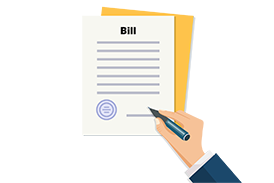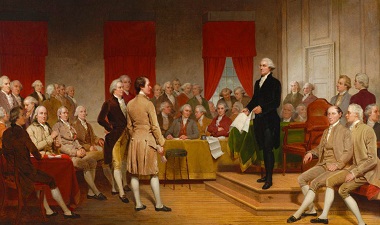
Getting Started
This module includes an Unboxing the Constitution video (5 min), Inside the Constitution video (6 min), student activities, and a learning project. Download the Teachers Guide and the Student Content Guide for more details on content and implementation. Course materials are provided in Google documents, Word documents, as well as printable PDFs.
A preview of the module can be accessed below.
Topics covered include:
- Branches of Government
- Identifying roles and responsibilities
- Defining Federalism

Vocabulary
At the beginning of each module, students are presented with vocabulary words and definitions.
Concept Words
Concept words are conceptually related to the big ideas in what they’re learning. These connect directly to the core concepts or themes of the lesson or unit and help students grasp the main ideas and how everything fits together.
- bicameralism: a lawmaking body with two houses, like the Senate and House of Representatives
- branches of government: the three parts of government: legislative, executive, and judicial
- checks and balances: a system where each branch of government can limit the power of the other branches
- executive order: a rule made by the president that has the power of law
- federalism: a system where power is shared between a central government and state governments
- judicial review: the power to review the constitutionality of acts of the national and state governments
- legislation: laws made or proposed by a government
- original jurisdiction: a court’s power to hear a case first, before any other court
- override: when lawmakers cancel a vetoed law by voting for it again with larger numbers
- separation of powers: dividing government powers into different branches
- term limit: a rule that limits how many times a person can be elected to an office
- veto: an official rejection of a law passed by a legislature
Speed Bump Words
Speed bump words are words that aren’t central to the concept being taught, but if students don’t understand them, they may struggle to comprehend the text or lesson. These words can help shape students' overall understanding of the topic.
- appointment: when someone is chosen for a job or position
- commerce: the buying and selling of goods and services
- tenure: the length of time a person can stay in a job or position
- treaty: a written agreement between countries

Topic 1: The Separate Branches of Government and Their Powers
Instead of giving all the power to one person or group, the Framers split power in two main ways: through Separation of Powers and through Federalism. One way to think of these different methods of dividing power is to see the first as a horizontal division of power and the second as a vertical division of power. Power within the federal government is divided horizontally into three independent branches: the executive branch (the President), the judicial branch (the courts), and the legislative branch (Congress). The legislative branch is also split into an upper house (Senate) and a lower house (House of Representatives). Each branch has distinct responsibilities, and there is a system of checks and balances to prevent any one branch from becoming too powerful.
6.1: Activate Prior Knowledge
What comes to mind when you hear “separation of powers” or “checks and balances”? Ask students individually, or work together as a class, to make a list of all of the words, names, and phrases they can think of.
Unboxing the Constitution
In this Unboxing the Constitution video, Lucy explores the events, ideas, and influential people connected to the concepts of separation of powers and federalism.
6.2: Defining Key Terms
Have students watch the Inside the Constitution video and listen for clues on how to define key terms. Afterward, consider why the framers believed that separation of powers was so important.
Inside the Constitution
6.3: Branches Breakdown
Students will dive into a Branches Breakdown worksheet to learn about the people involved, the rights and responsibilities, and how it connects to the other two.
6.4: Who is in Charge?
Consider different responsibilities and actions, and identify which branch of government is responsible for it.
6.5: Closing Activity
Students will check in on the Key Question(s).

Topic 2: Understanding Federalism
It’s clear that the separation of powers establishes that each branch has different roles and responsibilities. There are times when each branch has the power to work alone and other times when branches must work together. But creating three branches of government was not the only way the framers built in a separation of powers and checks and balances. The founders divided power between the national government and the states under a system known as federalism. Where do the ideas behind federalism appear in the Constitution?
6.6: Federalism
Students will use the Article Analysis worksheet to investigate how federalism is addressed. They should consider the purpose of having checks and balances in the government, and what some potential challenges to this structure could be.
Review the Teachers Guide for this module for insight on the difficulty of each article and implementation tips for meaningful classroom application.
6.7: Civic Connection: Should this be a Federal or State Law?
In this Civic Connection activity, students will consider the laws they would create, and if those laws would be more appropriate at a state level or a national level.
6.8: Reflect
To end this module, students will revisit the brainstorm from the beginning of the module to see how insights have grown throughout the lesson.

Learning Project: Should this be a Federal or State Law?
In this activity, students will explore how questions about federalism and the separation of powers still come up with more modern issues by role-playing as reporters and production staff to create a news broadcast about the debates.













